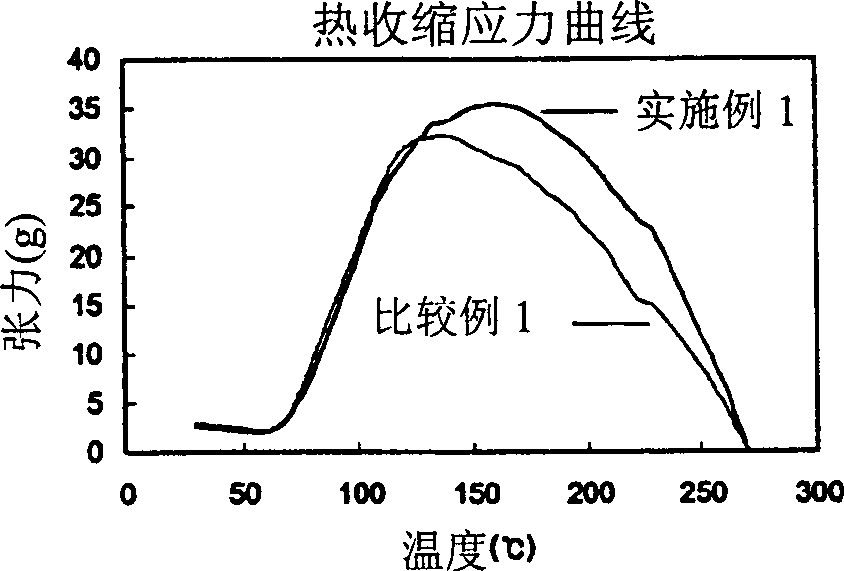Composite fibre and producing method thereof
A composite fiber and manufacturing method technology, applied in fiber processing, rayon manufacturing, fiber chemical characteristics, etc., can solve the problems of inability to obtain molecular weight distribution, no molecular weight and molecular weight distribution, etc., and achieve the minimum reduction in raw silk physical properties and stretchability chemical, good product stability, and excellent expansion and contraction properties
- Summary
- Abstract
- Description
- Claims
- Application Information
AI Technical Summary
Problems solved by technology
Method used
Image
Examples
Embodiment 1
[0078] In the manufacture of crimped conjugate fibers, polyethylene terephthalate with a number average molecular weight (Mn) of 12632 and a molecular weight distribution index (PDI) of 2.2 and a number average molecular weight (Mn) of 19149 with a molecular weight distribution index ( PDI) is the poly(trimethylene terephthalate) of 2.4, and its weight ratio is 5: 5, utilizes existing melt composite spinning equipment, with figure 2 - (d) eccentric core-sheath cross-section, set the spinning temperature at 270°C, spinning speed at 2200 m / min, residence time in the module at 4 minutes, and manufacture polyester composite fibers with a monofilament fineness of 3.4 denier . The conjugated fiber obtained by the above-mentioned spinning / coiling was stretched by another stretching device to produce a crimped stretchable conjugated fiber imparted with a spring-shaped crimp, and its single filament fineness was 2.1 denier. Table 1 shows the results of stretching at a stretching rati...
Embodiment 2
[0080] In the manufacture of crimped conjugate fibers, polyethylene terephthalate with a number average molecular weight (Mn) of 15385 and a molecular weight distribution index (PDI) of 2.1 and a number average molecular weight (Mn) of 33522 and a molecular weight distribution index ( PDI) is the poly(trimethylene terephthalate) of 2.1, and its weight ratio is 5: 5, utilizes existing melt composite spinning equipment, with figure 2 - (a) side-by-side section, set the spinning temperature to 275°C, the spinning speed to 2600 m / min, and the residence time in the module to be 4 minutes to produce a polyester composite fiber with a single filament fineness of 3.4 denier. The conjugated fiber obtained by the above-mentioned spinning / coiling was stretched by another stretching device to produce a crimped stretchable conjugated fiber imparted with a spring-shaped crimp, and its single filament fineness was 2.1 denier. Table 1 shows the results of stretching at a stretching ratio of ...
Embodiment 3
[0082] In the manufacture of crimped conjugate fibers, polyethylene terephthalate with a number average molecular weight (Mn) of 18211 and a molecular weight distribution index (PDI) of 2.1 and a number average molecular weight (Mn) of 88245 with a molecular weight distribution index ( PDI) is the poly(trimethylene terephthalate) of 1.6, and its weight ratio is 5: 5, utilizes existing melt composite spinning equipment, with figure 2 -(a) side-by-side section, set the spinning temperature to 285°C, the spinning speed to 3800 m / min, and the residence time in the module to be 4 minutes to produce a polyester composite fiber with a single filament fineness of 3.4 denier. The conjugated fiber obtained by the above-mentioned spinning / coiling was stretched by another stretching device to produce a crimped stretchable conjugated fiber imparted with a spring-shaped crimp, and its single filament fineness was 2.1 denier. Table 1 shows the results of stretching at a stretching ratio of ...
PUM
| Property | Measurement | Unit |
|---|---|---|
| Heat shrinkage stress | aaaaa | aaaaa |
| Curl diameter | aaaaa | aaaaa |
| Stretch temperature | aaaaa | aaaaa |
Abstract
Description
Claims
Application Information
 Login to View More
Login to View More - R&D
- Intellectual Property
- Life Sciences
- Materials
- Tech Scout
- Unparalleled Data Quality
- Higher Quality Content
- 60% Fewer Hallucinations
Browse by: Latest US Patents, China's latest patents, Technical Efficacy Thesaurus, Application Domain, Technology Topic, Popular Technical Reports.
© 2025 PatSnap. All rights reserved.Legal|Privacy policy|Modern Slavery Act Transparency Statement|Sitemap|About US| Contact US: help@patsnap.com



